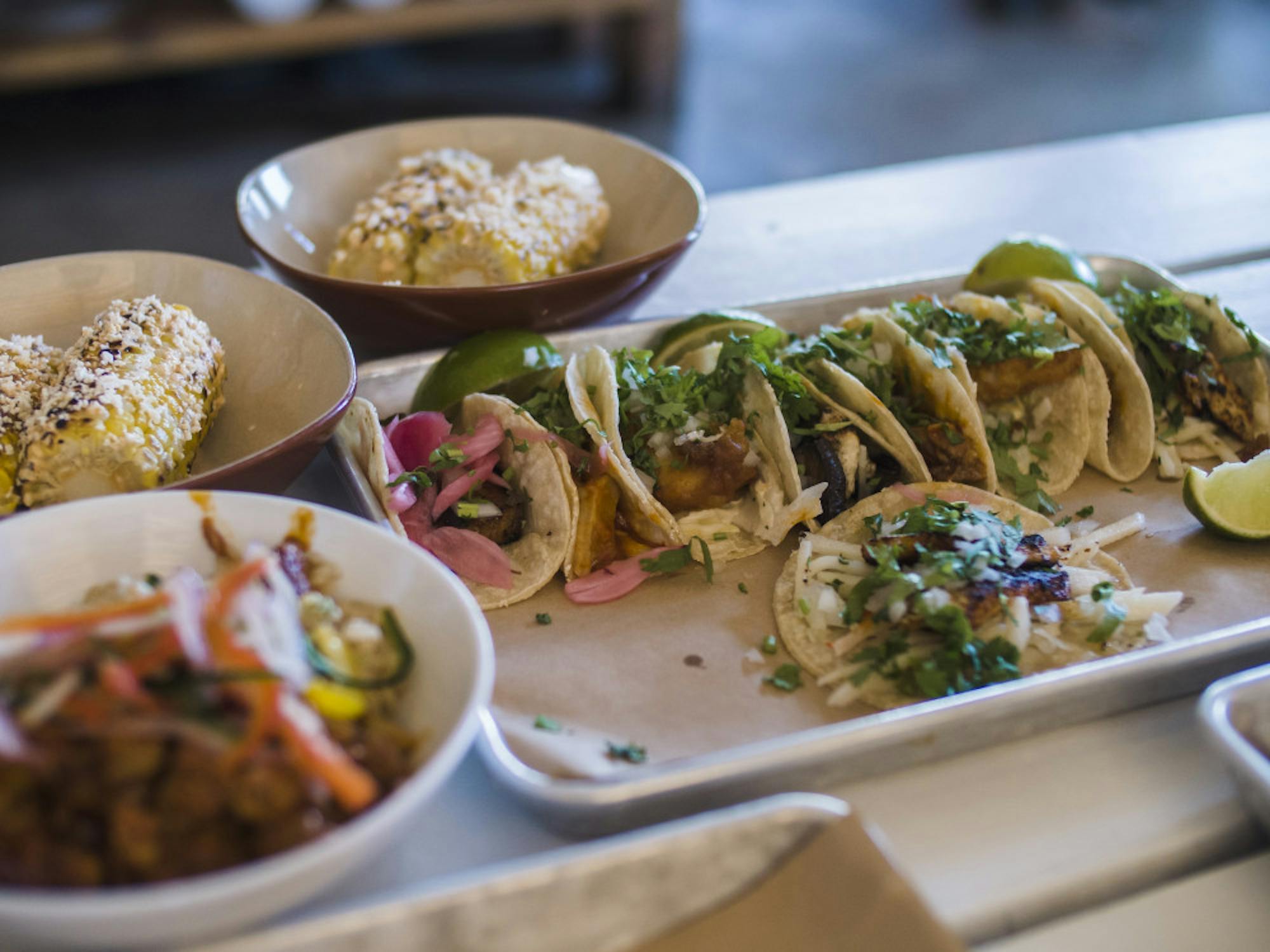While there’s nothing that the Daily Arts section loves more than a tale about teenage vagabonds causing mischief in Miami over that precious and precocious nine days in almost-spring (à la Harmony Korine’s 2012 masterpiece “Spring Breakers,” because who doesn’t love machine guns, a blonde Vanessa Hudgens and a hawaiian-shirt clad James Franco?), we know that sometimes the Spring Break activities that are the most fun are the ones that aren’t Instagrammed ad-infinitum. Let these under-the-radar artsy hidden gems from Spring Break 2015 inspire your next vacation.
From Viking exhibitions in Chicago to wacky taco restaurants in Atlanta to sunny and sensual arts exhibitions in San Diego, today we bring you some of the coolest and most offbeat artsy offerings from across the country.
Bartaco delivers good food, mixed messages
Bartaco, situated in West Midtown, Atlanta, is yet another extension of the Barteca restaurant group. Barteca’s reach expands throughout the entirety of the east coast and is known for consistently providing delectable eats, including Barcelona Wine, Bar & Restaurant which has locations in D.C., and another closer to home, in Boston’s South End. Upon pulling up to bartaco in West Midtown, though, one is sure to think their Uber driver had trouble following the GPS instructions. Slapped into a medley of a few other restaurants, all with a similar gray, uninviting exterior, bartaco is at first extremely underwhelming. It’s this outside appearance that allows for such an impact when entering the restaurant itself.Although bartaco does not take reservations, they suggest calling around 30 minutes before one plans to dine there so the waitstaff can prepare the dining room for the evening. While this system sounds inefficient and risky initially, bartaco keeps its promise, with little to no wait even for a large party of eight people. The host was attentive to every need of the patrons and made sure any waiting process was as quick and painless as possible. Bartaco obviously puts in a considerable amount of effort in order to develop a gimmicky tone, an entertainment aspect that can be important in the restaurant business but, if executed poorly, can come off as a corny failed attempt. Bartaco falls somewhere in between the two extremes of success and failure. The waiter, after spending a considerable amount of time at the table, gave the walk-through of operations at bartaco — the most important of which was that if a table was ever in need of anything, a blue dragonfly card was to be placed on the table, and any server would attend to the question or issue. It’s a seemingly interesting idea, but in the end, the blue card was not an effective way of tracking down a server and guests usually resorted to the more typical “waving down.”
Bartaco’s menu consists of an array of appetizers and some sides, but the bulk of its menu is comprised of its variety of tacos, priced at $2.50 each and offered with a variety of atypical toppings like wild boar, hamachi and pork belly, as well as more traditional favorites like chicken and spicy chorizo. The menu ended up being another area of confusion. It was unclear if a table should place orders as a group, almost in a “family style” manner, or if each restaurant-goer orders individually. In the latter case, it was unclear how many tacos were an appropriate amount for diners, and no server prompted could give an exact explanation. Large trays were offered in order to accommodate bigger parties, but because of the inability to choose which tacos came on the tray, it ended up seeming impossible to please the whole table.
However, when the food was finally sorted out and brought to the table, its quality nearly cancelled out the negatives of the ordering process. The guacamole was a table favorite, served with large, circular nachos that were meant to be broken apart, as opposed to tortilla chips. Margaritas were an additional table winner, somehow pinpointing the perfect balance between sweet and savory and strong and diluted, with the convenient option of ordering carafes for the table. Other items are listed under a different section on the menu, jokingly named “not tacos,” and include pork tamales, plantains and hamachi ceviche. But, in the end, the tacos were the most appealing option on the menu, and some standouts included the prime rib, mushroom and cauliflower tacos.
In attempts to “do something different,” bartaco ends up as an ineffective gimmick that leads to more confusion than necessary in the ordering process. Servers, although unable to communicate bartaco’s method, were in general friendly and did their best. Perhaps as it should be, bartaco’s best attribute was its food: while somewhat limited, it can be enjoyed by large groups and there is nothing gimmicky about its genuinely high-quality flavors.
Bartaco has locations across the country and is part of Barteca Restaurant Group which also operates Barcelona Bar and Grill in Brookline and in Boston’s South End. Barcelona Restaurant and Wine Bar in Boston is located at 525 Tremont Street, Boston, Mass. 02116. Reservations can be made by phone at (617) 266-2600. Dinner hours are Monday – Thursday: 4 p.m. – late, Friday: 4 p.m. – late, Saturday: 4 p.m. – late and Sunday: 4 p.m. – late.
The Field Museum's 'Vikings' informs, entertains
Whether you’re already planning to take a trip to the windy city over the fastly approaching summer break, are an avid fan of the History Channel’s “Vikings” (2013-present) television series — praised by Daily Writer and Editor Grace Segers — or are just looking for something new, the Chicago Field Museum’s “Vikings” special exhibition may fit the bill. Upon entering the exhibition, housed in a darkened room with illuminated cases for artifacts from Scandinavia, visitors are introduced to what actually constitutes a “Viking.”
As one placard explains, “there is no single definition for the word ‘Viking.’ It is sometimes used to describe a situation or an activity. Someone could be out on a ‘viking’ — a commercial trip or a raid … Uses of the word suggest that people could step in and out of different roles — a peasant, a trader, a Viking. Sources suggest that women, children and youths sometimes went ‘a viking,’ so perhaps almost everyone, at some time, was ‘a viking.’” Though unfortunately somewhat vague, it is understandable that over time, the true meaning of this word may have been lost. However, the explanation points to another topic widely covered in the exhibition: the role of women in Viking society. While, again, “records are unclear about women’s role …” according to exhibition materials, “archaeological evidence shows that they ruled the household and the farm, both central roles in society.”
Additionally, the visitor learns later in the exhibition that “Norse women could be both highly regarded and feared, even if they had no legal power. Aristocratic women were said to be able to predict and manipulate destiny. These abilities were associated with real life Völur and with mythological Norns and Valkyries.”
(In case you didn’t know, Völurs were women “believed to be able to predict the future, just like the goddess Freyja” while the Norns and Valkyries had the ability to influence and end human lives, respectively.)
The spiritual and religious lives of Vikings are covered in impressive detail. Visitors are able to sit and listen to three different myths involving a host of gods and goddesses, and are able to use an interactive touch screen to look at the creation story and various levels of the underworld and heavens. The creation video and in-depth explanations of Norse mythology are some of the most informative offerings, while other aspects of “Vikings,” such as explanations of family life, the structure of houses and discussions of tools used by the Vikings, are more intuitive, or at least in line with common perceptions of this group of people.
Interestingly, “there are no contemporary sources that describe the Old Norse religious beliefs and practices of Scandinavian people,” according to the show. Thus, a great deal of information in the exhibition is derived from an “account […] written around 1220-1230 by the Icelandic Chieftain and poet, Snorri Sturluson.” A notable distinction between the gods and giants of Old Norse religious beliefs and those of most monotheistic religions today is that for the Old Norse, “gods were not moral role models. Gods and giants resembled humans and had complex personalities — they fought amongst themselves, but could also live together peacefully.”
Clearly, the Field Museum’s special exhibition “Vikings” is highly informative, though it arguably is directed at a younger audience. Tufts students would likely enjoy the game of Hnefatafl, which visitors are able to play against each other on touch screens. Friends may also enjoy competing to score well on the quizzes to test their knowledge at the end of the exhibit; they proved to be surprisingly difficult. Beautiful pieces in the exhibition include actual beads found in graves of various Vikings, replicas of broaches and other forms of fashion worn by this illustrious group. An added bonus: the life-sized elephants in the main hall located right outside the exhibit is a perfect photo spot for Jumbos. The “Vikings” exhibition at the The Field Museum runs through Oct. 4.






